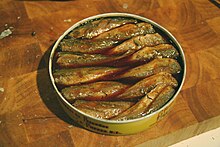Atlantic horse mackerel
| Atlantic horse mackerel | |
|---|---|

| |
| Scientific classification | |
| Domain: | Eukaryota |
| Kingdom: | Animalia |
| Phylum: | Chordata |
| Class: | Actinopterygii |
| Order: | Carangiformes |
| Family: | Carangidae |
| Genus: | Trachurus |
| Species: | T. trachurus
|
| Binomial name | |
| Trachurus trachurus | |
| Synonyms[3] | |
| |
The Atlantic horse mackerel (Trachurus trachurus), also known as the European horse mackerel or common scad, is a species of
Description
The Atlantic horse mackerel has quite a slender, quite compressed body with a large head in which the rear of the upper jaw reaches the front of the eye and the lower jaw projects beyond the upper jaw. The eye has a well developed
Distribution
The Atlantic horse mackerel occurs in the north and eastern
Habitat and biology
The Atlantic horse mackerel is a
The juveniles of thus species frequently often shoal with the juveniles of other fish species, mainly Atlantic herring (Clupea clupea) and with other species of horse mackerels such as the Mediterranean horse mackerel (T. mediterraneus) and blue jack mackerel (T. picturatus).[4] Juveniles are also often encountered sheltering in the tentacles of jellyfish. In South Africa the maximum recorded age is 24 years while 40 years of age has been recorded in the northeast Atlantic. They are thought to breed from two to four years old for females. Off Mauritania, the juveniles are caught at depths of 200–300 m (110–160 fathoms; 660–980 ft) while mature fish are taken in shallower waters of less than 100 m (55 fathoms; 330 ft).The age and growth of the Atlantic horse mackerel vary across its extensive range and are affected by the levels to which stocks are exploited.[1]
The diet of this species, in both juveniles and adults, is
Taxonomy and naming
The Atlantic horse mackerel is the
The common name horse mackerel has been said to derive from the belief that other fishes rode on its back but it may derive from the old Dutch word Horsmakreel which means a mackerel which spawns over a shallow or bank, a hors, and this was taken into English as "horse mackerel".[13]
The Cape horse mackerel (Trachurus capensis) is considered to be the subspecies T. trachurus capensis of the Atlantic horse mackerel by some authorities and it is thought that there is no adequate series of these specimens of this taxa along the coast of Africa available to confirm the validity of this taxon.[8]
Fisheries

The Atlantic horse mackerel is fished for commercially using trawls, longlines, purse seines (using artificial light), traps and on line gear. In 1999 the Food and Agriculture Organization stated that the total catch reported to it was 322 207 tonnes with the largest catches being in the Netherlands and in Ireland.[4] There is a total allowable catch (TAC) in the North Sea for this species and landings have consistently been below this level[14] but the TAC is not in line with the scientific advice. There have been calls to create a management plan for the Atlantic horse mackerel in the North Sea but currently there are no specific management objectives for it. The stock needs to be assessed and management objectives should be set before the fishery can be shown to be sustainable.[15]
Conservation
The
Human uses
The Atlantic horse mackerel is consumed fresh. It may be preserved by freezing, salting and drying, smoking and canning. It can be prepared by frying, broiling or baking.[4] The flesh is said to have a pleasant flavour with an oily delicate texture which is a good source of omega-3 fatty acids.[16] Nutritionally 100g of the flesh of the Atlantic horse mackerel provides 97 kcal of energy and is made up of:[17]

- Water: 77.4 g
- Protein: 19.8 g
- Fat: 2 g
- Cholesterol: 64.4 mg
- Total minerals: 1.3 g
- Phosphorus: 224 mg
In Iberia it may be prepared as an escabeche while some are exported to Japan as aji to be used in sushi.[18] They are also an important ingredient in Sicilian cuisine.[17]
References
- ^ . Retrieved 19 November 2021.
- ^ Eschmeyer, William N.; Fricke, Ron & van der Laan, Richard (eds.). "Scomber trachurus". Catalog of Fishes. California Academy of Sciences. Retrieved 8 December 2019.
- ^ a b Froese, Rainer; Pauly, Daniel (eds.) (2019). "Trachurus trachurus" in FishBase. August 2019 version.
- ^ a b c d e f g "Species Fact Sheets Trachurus trachurus (Linnaeus, 1758)". FAO Fish Finder. Food and Agriculture Organization.
- ^ ISBN 978-1855853645.
- ^ a b c d J.C. Hureau (ed.). "Atlantic horse-mackerel (Trachurus trachurus)". Fishes of the NE Atlantic and the Mediterranean. Marine Species Identification Forum. ETI Bioinformatics. Retrieved 8 December 2019.
- ^ a b c d e "Trachurus trachurus – horse mackerel". Northern Ireland Priority Species. National Museums Northern Ireland. Retrieved 8 December 2019.
- ^ .
- S2CID 84595326. Abstract
- ^ Eschmeyer, William N.; Fricke, Ron & van der Laan, Richard (eds.). "Species in the genus Trachurus". Catalog of Fishes. California Academy of Sciences. Retrieved 8 December 2019.
- ISBN 978-1-118-34233-6. Archived from the originalon 2019-04-08. Retrieved 2019-12-08.
- ^ Christopher Scharpf; Kenneth J. Lazara (10 August 2019). "Order CARANGIFORMES (Jacks)". The ETYFish Project Fish Name Etymology Database. Christopher Scharpf and Kenneth J. Lazara. Retrieved 8 December 2019.
- ^ "Horse Mackerel". Royal Netherlands Institute for Sea Research. Retrieved 8 December 2019.
- ^ "Atlantic horse mackerel North Sea". Sustainable Fisheries Partnership. Retrieved 8 December 2019.
- ^ "Scad, Horse Mackerel". Good Fish Guide Online. Marine Conservation Society. Retrieved 8 December 2019.
- ^ "Horse mackerel in marinade". Food and Wine from Spain. Retrieved 8 December 2019.
- ^ a b "Horse mackerel". Pescato di Sicilia. Retrieved 8 December 2019.

